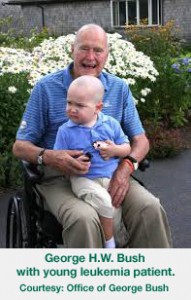April 8, 2020 by Adrienne Sylver
A Cord that Ties Us Together

 Last week, cable news outlets and social media displayed photos of former president George H.W. Bush with a bald head, holding a young child, with an equally bald head, who is battling leukemia.
Last week, cable news outlets and social media displayed photos of former president George H.W. Bush with a bald head, holding a young child, with an equally bald head, who is battling leukemia.
Bush and his entire Secret Service detail reportedly shaved their heads in a show of solidarity for the child, whose father was part of that detail. Bush’s own daughter Robin died of leukemia when she was 3, making his gesture that much more meaningful in the eyes of the world.
Today, children and adults with blood diseases like leukemia have new hope for recovery thanks to stem cells harvested from blood left in the umbilical cord and placenta after mothers give birth.
Those stem cells – not the controversial embryonic type – were traditionally thrown out with the umbilical cord and placenta as medical waste. But research showed the blood left in those structures was a rich source of these unspecialized cells that produce platelets, as well as red and white blood cells.
When these cells were transplanted into patients with more than 70 different blood disorders, like leukemia, sickle cell anemia and lymphoma, the patients showed remarkable recoveries, according to research published in the New England Journal of Medicine, and in some cases, were cured.
Thanks to the efforts of local cardiologist Harry Aldrich, M.D., parents delivering their babies at South Miami Hospital and Baptist Hospital have the option of donating their newborn’s umbilical cord blood for free to the CORD:USE Cord Blood Bank, a public and family cord blood bank, linked to the National Marrow Donor Program.
Public cord blood banking differs from private banking in that public donation is free and donated blood is available to anyone on the National Marrow Donor Program registry. With private banking, donors must pay a fee for collection and storage, but the blood is only available to them and their families.
Dr. Aldrich spearheaded bringing the public donation programs to both hospitals after his own son was successfully treated through a cord blood transplant for leukemia several years ago.
“I am very happy to say that my son is leading a normal teenage life now,” he said. “Cord blood donated by parents at South Miami and Baptist Hospitals may one day save the life of a child or adult.”
Parents, who deliver their babies at one of these hospitals and wish to donate, give their consent prior to delivery. Then the blood is collected from the umbilical cord and placenta and sent to CORD:USE Cord Blood Bank for testing and cataloging into the National Marrow Donor Program Registry.
With more than 8,600 births in 2012, families donating cord blood at South Miami and Baptist Hospitals supply a valuable source of cord blood donations each year, according to CORD:USE. Because of Miami’s culturally diverse population, the cord blood collected here fills a void in the national registry, in which ethnic minorities are underrepresented.
“The parents who choose to donate are thrilled with this program,” said Rene Paez, M.D., chief of obstetrics and gynecology at South Miami Hospital’s Center for Women & Infants. “They appreciate the opportunity to help countless unnamed people throughout the world living with life-threatening blood diseases.”
For more information about donating umbilical cord blood at South Miami Hospital or Baptist Hospital, contact Maternity Pre-Registration.
top stories












There are no comments